The content of this introduction paper is based on the article "Modeling and Simulation of 0.5 HP Rotating Machine for the Investigation of Losses by Using Copper as Rotor Bar Material" published by ['Australian Journal of Basic and Applied Sciences'].
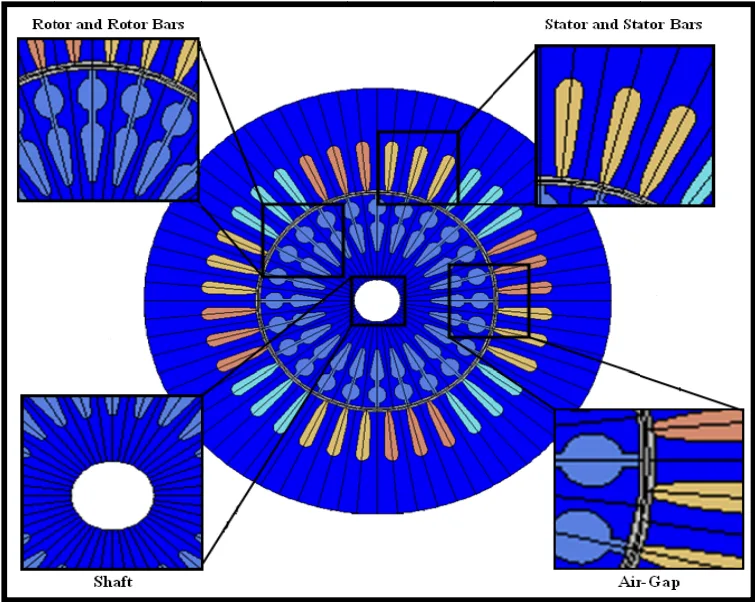
1. Overview:
- Title: Modeling and Simulation of 0.5 HP Rotating Machine for the Investigation of Losses by Using Copper as Rotor Bar Material
- Author: I. Daut, N. Gomesh, Y. Yanawati, M. Irwanto, S. Nor Shafiqin, Y.M. Irwan
- Year of publication: 2011
- Journal/academic society of publication: Australian Journal of Basic and Applied Sciences, 5(12): 179-188, 2011
- Keywords: Induction Motor, Simulation, Losses, Efficiency, Copper, Aluminium.
2. Abstract:
In this paper, the 0.5HP three phase AC induction motor have been investigated and analyzed. Through out this project, an induction motor is design by AutoCAD software and then simulated by using the FEM software. It is then compared with another conventionally used rotor bar. The first part of comparison is done with FEM Simulation by modeling the induction motor of aluminium rotor bar and copper rotor bar for the same 0.5HP configuration of stator slot design and winding configuration. The simulation is compared in terms of power loss, magnetic flux density, magnetic field intensity, eddy current density, torque vs. speed, torque vs. slip, power loss vs. speed and power loss vs. slip. From the overall experiment of software simulation, results shows that in the magnetic flux density (B) between the aluminium and copper rotor bars analysis, the high electrical conductivity can provide lower resistivity of the material, this means the copper rotor bars has lower impedance thus lower losses. The entire analysis shows some good benefits towards the usage of copper material rotor bars.
3. Introduction:
Based on the analysis of industrial energy use in Malaysian companies, it has been found that electrical motors used the highest amount of energy (47%) (Saidur, R., 2009). Majority of motors in the industry are induction motors. One of established procedures to detect the output power of a motor is to calculate the efficiency by measuring the losses and subtract them from the input (Chapman, S.J., 2005). The induction motor machine is an important class of electric machines which finds wide applications. More than 85% of industrial motors in use today are in fact induction motors (Theodore, W., 2006).
The losses of the AC induction motor can be divided into five categories: stator copper loss, rotor copper loss, core loss, stray load loss and friction and windage losses (Turner, D.R., 1991). Stator and rotor copper loss make up the largest share. Iron or core loss is frequency-dependent and can affect the efficiency.
The aim of this research is to investigate the losses in AC induction motor using different rotor bar material which is copper and aluminium and to obtain the efficiency and performance of the induction motor in both rotor materials. The objective of this research can be summarized as follows:
- Design and simulation of three phase AC induction motor using Opera 2D software version 12.0 for aluminium and copper rotor bars.
- To construct a rotor with copper rotor bar and compare it with the existing aluminium rotor bars of the 0.5HP induction motor.
- To investigate the performance of the copper rotor bar in terms of efficiency, power factor, losses reduction potential and economical aspect analysis in terms of money and energy saving.
- To investigate the efficiency of the 0.5HP AC induction motor based on loss parameters such as stator copper loss, rotor loss, core loss, friction & windage losses and stray load loss in both rotors.
4. Summary of the study:
Background of the research topic:
The efficiency of induction motors is crucial for energy saving. Motor losses such as stator copper loss, rotor loss, core loss, friction and windage loss, and stray load loss directly impact efficiency. Reducing these losses can increase motor efficiency and decrease energy consumption. Increasing the efficiency of electric machines, especially small motors, is a significant challenge in their production.
Status of previous research:
Calculations of iron losses in electrical machines are normally based on experimental characteristics of core material used in the machines. Different standards worldwide make it difficult to compare manufacturer efficiency numbers. Energy-efficient electric motors offer significant opportunities for cost-effective electricity saving.
Purpose of the study:
The aim of this research is to investigate the losses in AC induction motors with copper and aluminium rotor bars and to determine the efficiency and performance differences between the two materials.
Core study:
The study involves designing a 0.5HP three-phase AC induction motor in AutoCAD and simulating its performance using FEM software with both aluminium and copper rotor bars. The simulation results are compared in terms of power loss, magnetic flux density, magnetic field intensity, eddy current density, torque vs. speed, torque vs. slip, power loss vs. speed, and power loss vs. slip.
5. Research Methodology
Research Design:
The research employs a simulation-based comparative study. A 0.5HP three-phase AC induction motor is designed, and two virtual models are created in FEM software, differing only in the rotor bar material (aluminium and copper). Steady-state AC analysis is performed on both models.
Data Collection and Analysis Methods:
The FEM software (Opera 2D version 12.0) is used to simulate the electromagnetic behavior of the induction motor with both rotor bar materials. The software calculates and provides data on magnetic potential lines (POT), eddy current density (J²), magnetic flux density (Bmod), magnetic field strength (Hmod), torque, speed, slip, and power loss. The simulation data is then exported and analyzed to compare the performance of the motor with aluminium and copper rotor bars.
Research Topics and Scope:
The research focuses on a 0.5 HP, 415V, 1.02A induction motor with a power factor of 0.74, a synchronous speed (n<0xE2><0x82><0x98>) of 1500rpm, a supply frequency of 50Hz, and 4 poles. The stator has 36 slots, and the rotor has 24 slots. The study investigates the impact of rotor bar material (aluminium vs. copper) on various performance parameters and losses.
6. Key Results:
Key Results:
- Magnetic Flux Density (B): Copper rotor bars exhibit lower magnetic flux density (1.34 Tesla) compared to aluminium rotor bars (1.36 Tesla), indicating lower impedance and thus lower losses due to the higher electrical conductivity of copper (5.8× 10⁷ Sm⁻¹) compared to aluminium (3.77 × 10⁷ S.m⁻¹).
- Magnetic Potential Lines (POT): The magnetic pole distribution is more uniform with copper rotor bars, suggesting lower hysteresis losses. Copper rotor bars also show less flux leakage compared to aluminium.
- Eddy Current Density: Copper rotor bars have lower eddy current density than aluminium rotor bars at 50Hz, leading to decreased losses.
- Torque vs. Speed: The starting torque for aluminium is 2.09 N-m, and for copper, it is 1.63 N-m. The breakdown torque is 4.8 N-m for both materials, but the copper rotor bar torque breaks down faster than the aluminium rotor bar torque.
- Torque vs. Slip: At a slip of 0.05, the torque with copper rotor bars (2.5 N-m) is higher than with aluminium rotor bars (1.7 N-m).
- Power Loss vs. Slip: At a slip of 0.05, the power loss with aluminium is 5.45W, and with copper is 7.72W. However, beyond a slip of 0.2, aluminium losses increase dramatically compared to the steadier increase in copper losses.
- Power Loss vs. Speed: At starting condition (0 rpm), copper rotor bars have a lower power loss (130.44W) than aluminium rotor bars (157.23W). The losses decrease with increasing speed, and copper losses decrease more linearly and faster than aluminium losses after 1200 rpm.
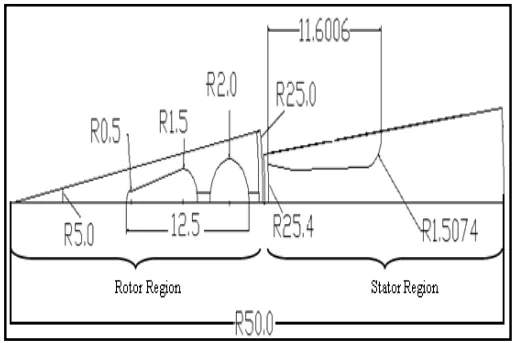
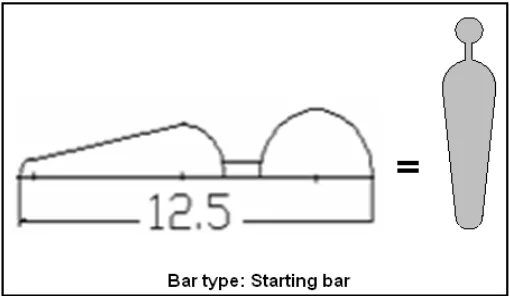
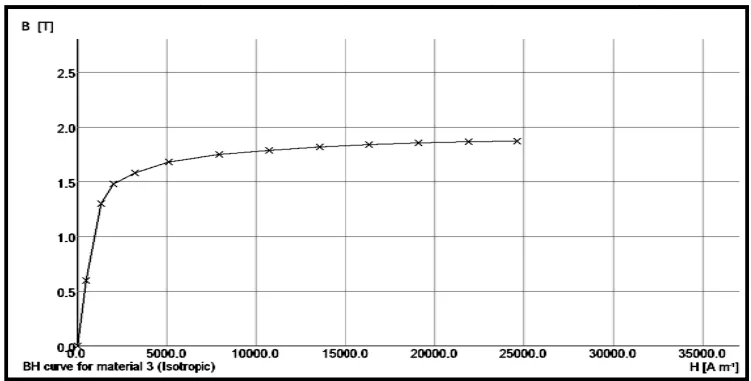
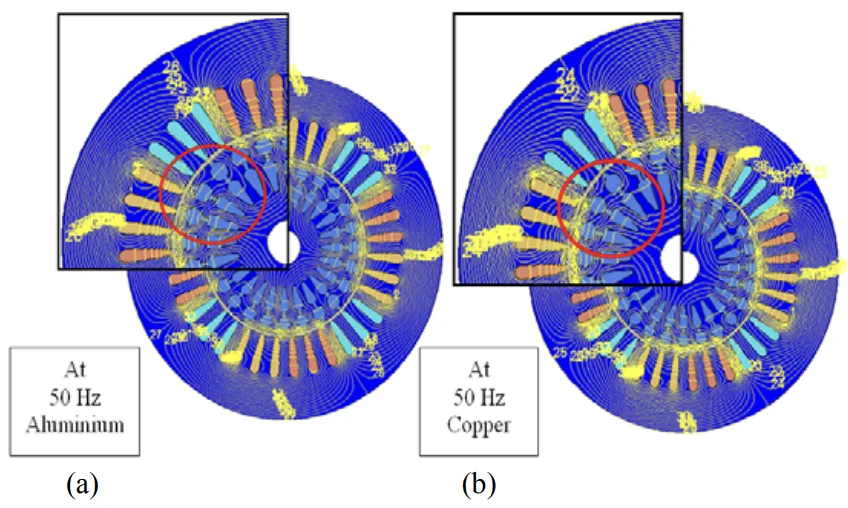
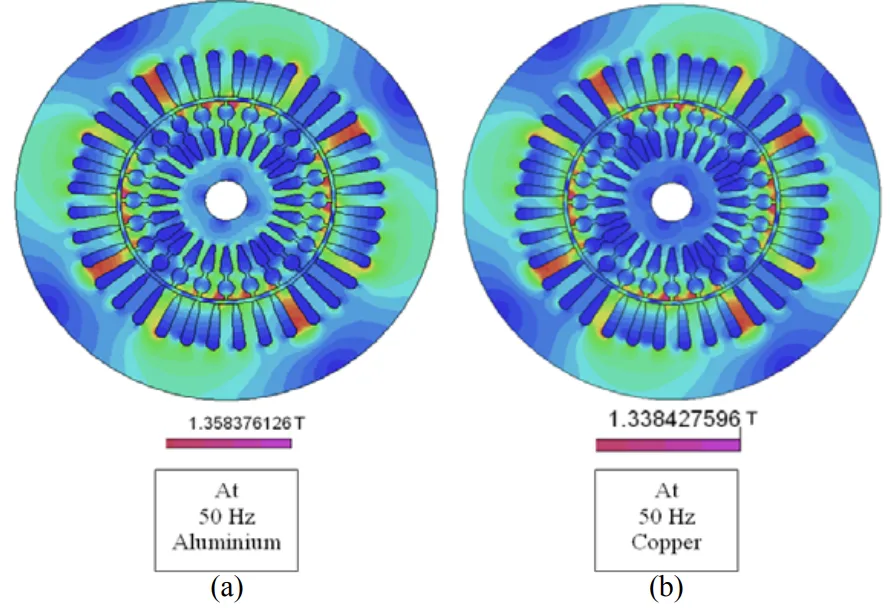
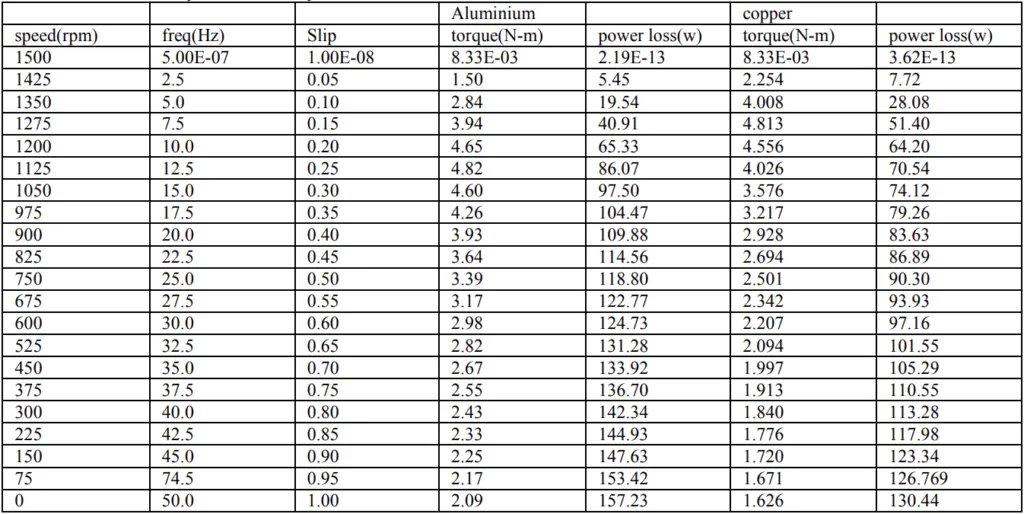
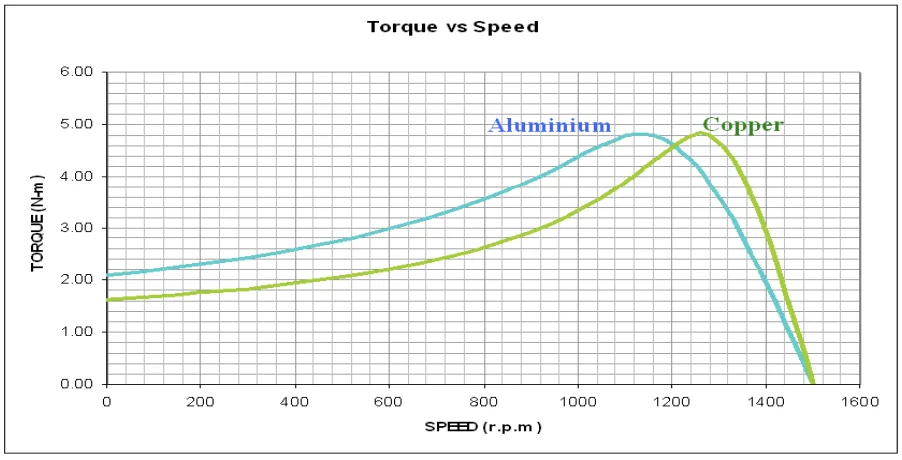
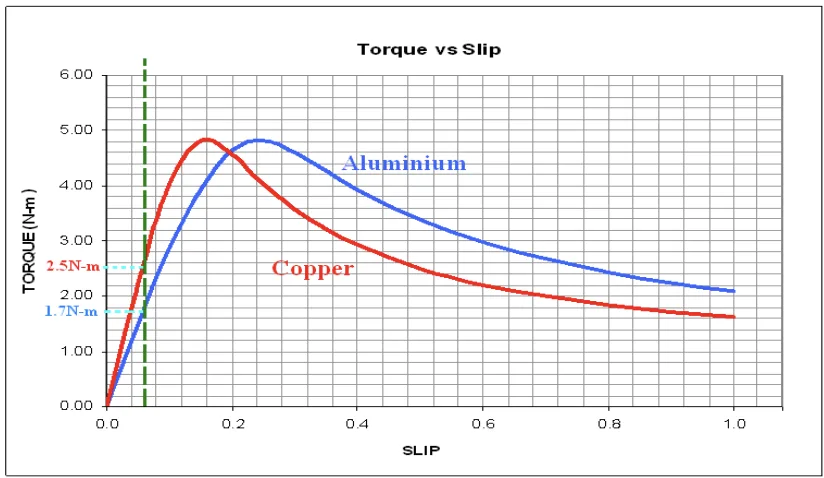
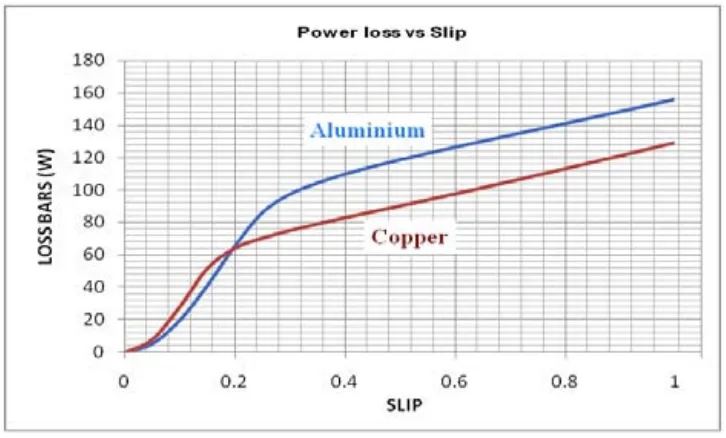
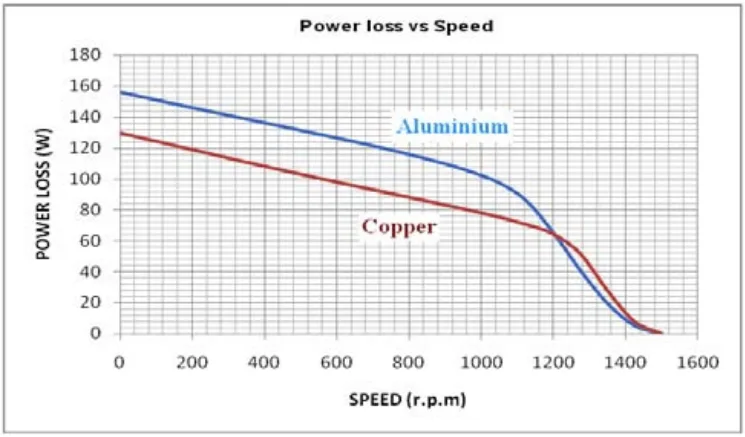
Figure Name List:
- Fig. 1: Induction Motor Stator and Rotor Design Specifications.
- Fig. 2: Rotor Bar type of Half Rotor Slot for Opera 2D.
- Fig. 3: 2D view of Stator & Stator Bars, Rotor & Rotor Bars and Air Gap.
- Fig. 4: B-H Curve of the Copper and Aluminium Materials.
- Fig. 5: Half Pole AutoCAD Design of the Induction Motor.
- Fig. 6: Magnetic Line Potential based at 50 Hz.
- Fig. 7: Magnetic Line Potential based on Colored Zone at 50 Hz.
- Fig. 8: Eddy Current Density of Rotor Bar at 50 Hz.
- Fig. 9: Magnetic Flux Density of Rotor Bar at 50 Hz.
- Fig. 10: Magnetic Field Strength of Rotor Bar at 50 Hz.
- Fig. 11: Torque vs. Speed of Aluminum & Copper Rotor bar.
- Fig. 12: Torque vs. Slip comparison of Aluminum & Copper Rotor bar.
- Fig. 13: Power Loss vs. Slip of Aluminum & Copper Rotor bar.
- Fig. 14: Power Loss vs. Speed (r.p.m) of Aluminum & Copper Rotor bar.
7. Conclusion:
The modeling and FEM simulation indicate that using copper as the rotor bar material in a 0.5 HP induction motor offers several advantages over aluminium. The higher electrical conductivity of copper leads to lower resistivity, lower impedance, and consequently lower losses. Copper rotor bars exhibit a more uniform magnetic pole distribution, lower eddy current density, and better magnetic flux density characteristics, which can reduce core losses. While the starting torque is slightly lower with copper, the torque at normal operating slip is higher, and the torque breakdown is faster, which can protect the motor from overheating during overload conditions. The power loss analysis shows that copper rotor bars have lower losses at starting and high-speed conditions compared to aluminium. Overall, the study suggests that copper is a better material for rotor bars in terms of reducing losses and improving the performance of the induction motor.
8. References:
- Chapman, S.J., 2005. Electric machinery fundamentals (4th ed). New York: McGraw-Hill.
- Saidur, R., N.A. Rahim, H.H. Masjuki, S. Mekhilef, H.W. Ping and M.F. Jamaluddin, 2009. "End-use energy analysis in the Malaysian industrial sector". Energy, 34(2): 153-158.
- Theodore, W., 2006. Electrical machines, drives and power systems (6th ed). New Jersey: Pearson Prentice Hall.
- Turner, D.R., K.J. Binns, B.N. Shamsadeen and D.F. Warne, 1991. “Accurate measurement of induction motor losses using balance calorimeter". Electric Power Applications, IEE Proceedings, 138(5): 233-242.
9. Copyright:
- This material is a paper by "I. Daut, N. Gomesh, Y. Yanawati, M. Irwanto, S. Nor Shafiqin, Y.M. Irwan". Based on "Modeling and Simulation of 0.5 HP Rotating Machine for the Investigation of Losses by Using Copper as Rotor Bar Material".
- Source of the paper: https://www.researchgate.net/publication/265542791
This material is summarized based on the above paper, and unauthorized use for commercial purposes is prohibited.
Copyright © 2025 CASTMAN. All rights reserved.